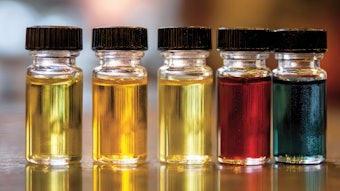Anethole's organoleptic profile is familiar to most of us as licorice. Until recently there were only negative reports of anethole's presence in licorice root, however one recent report has identified its presence at trace levels (i.e., 1.8 x 10-4% of the dry root). But it is added as a flavoring material. Its presence dominates the spices anise, star anise and fennel, which find wide use in all parts of the world. Thus, anethole’s organoleptic impression is best defined by the terms sweet, warm, anise-licorice, The impression falls into the class “herbaceous” and defines the term anise in an aroma chemical sense. Yet, the term anethole is an anomaly, as it is derived from the Greek word anethon, meaning dill, a plant and oil in which anethole appears only as minor constituent and in which it shades—but does not dominate—the character of the organoleptic impression.
Although anethole can be and sometimes is isolated from various anise oils in which it naturally occurs in high concentration (>90%), the current major commercial source of anethole is sulfate turpentine still bottoms. Anethole and its isomer estragol (methyl chavicol) are found only in minor concentrations in crude sulfate turpentine, thus its isolation would be impractical, if it were not for the huge volumes of turpentine crudes that are generated and processed for their other ingredients from U.S. southern pine trees. Anetholei isolation from this product stream places it as a by-product, which allows it to be priced at levels which vary considerably and often far below that level which would allow it to be produced by classical synthetic routes, This flexible price position has forced synthetic producers out of the market and prevents others from entering it.










